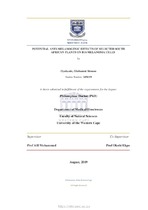| dc.description.abstract | Dyspigmentation is one of the commonest dermatological presenting complaints from patients, particularly hyperpigmentation. Hyperpigmentation can cause dangerous psychological and emotional impact on self-perception and health quality of lives of people affected. However, of all the diseases encountered globally, epidemiological data has shown that skin diseases account for almost 34% of all the diseases and these dermatological disorders have gotten worse over time. The gold standard for treatment of hyperpigmentation is hydroquinone. Despite its efficacy, hydroquinone and other current modalities of treatments are associated with some side effects. There are a number of natural products derived from medicinal plants that have proven to be an abundant source of biologically active compounds and a lot of these have served as the basis for the development of new lead chemicals for pharmaceutical. The present study focused on screening of selected South African plants (Maclura pomifera, Otholobium fruticans, Phyylica ericoides, Psoralea aphylla, Rhynchosia villosa, and Serruria furcellata) for their antimelanogenic potentials.
Methanol and ethyl acetate were used for the extraction of plant materials. Standard methods were employed for evaluation of cytotoxicity of the methanolic leaf extracts (MLE), ethyl acetate leaf extracts (ELE) and melanin synthesis potentials on B16 melanoma cells. To elucidate mechanisms of melanin reduction action, intracellular tyrosinase activity was determined by measuring the rate of L-DOPA oxidation. Tyrosinase activity was assessed further with dihydroxyphenylalanine (DOPA) staining. The mode of action was further determined by evaluating reactive oxygen species (ROS) and expressions of melanogenesis gene using qPCR.
The results showed that O. fruticans and S. furcellata reduced melanin synthesis without cytotoxicity.
O. fruticans inhibited tyrosinase activity, increased ROS and suppressed the expression of TYR, TRP-1, TRP-2/Dopachrome tautomerase, MITF, MC1R but upregulated β-Catenin. S. furcellata stimulated tyrosinase activity and did not increase ROS. It upregulated the expression of TYR, TRP-1, TRP-2, and MC1R while MITF and β-Catenin were suppressed. The results showed that O. fruticans reduced melanin synthesis via cAMP pathway while S. furcellata reduced the synthesis via possibly degradation of melanin pigment. The present study on O. fruticans and S. furcellata has shown that leaves of these plants are candidate anti-melanogenic agents. However, more work still needs to be done to elucidate other possible mechanisms that are relevant to antimelanogenic effects of these two plants. | en_US |

